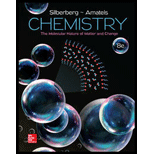
(a)
Interpretation:
For given voltaic cell with
Concept Introduction:
An
Galvanic cell consists of two half-cells. The redox reaction occurs in these half-cells. The half-cell in which the reduction reaction occurs is known as the reduction half-cell, whereas the half-cell in which the oxidation reaction occurs is known as the oxidation half-cell.
Anode: The electrode where the oxidation occurs is called as an anode. It is a negatively charged electrode.
Cathode: The electrode where reduction occurs is called as a cathode. It is a positively charged electrode.
Oxidation: The gain of oxygen or the loss of hydrogen or the loss of an electron in a species during a redox reaction is called as oxidation.
Reduction: The loss of oxygen or the gain of hydrogen or the gain of an electron in a species during a redox reaction is called as reduction.
Steps in
1) Divide the overall reaction into an oxidation half-reaction and a reduction half-reaction
2) Balance atoms other than
3) Balance
4) Balance
5) Balance charges by adding, as needed number of electrons,
6) Multiply the oxidation half-reaction with the coefficient of electrons in the reduction part.
7) Multiply the reduction half-reaction with the coefficient of electrons in the oxidation part.
8) Combine the two half-reactions, cancel out the species that appears on both side, so that number of elements that appear on both sides become equal.
9) For the reaction in acidic medium, the presence of
10) For the reaction in basic medium, the
11) Cancel out the species that appears on both sides and ensure that the number of atoms on the reactant side is equal to the number of atoms on the product side.
(b)
Interpretation:
The cell has to be drawn showing the electrodes with their charges and direction of electron flow along with the cation and anion flow in the salt bridge.
Concept Introduction:
An electrochemical cell is a device in which a redox reaction is used to convert chemical energy into electrical energy. Such device is also known as the galvanic or voltaic cell.
Redox reaction: Redox reaction is a type of
Oxidation: The gain of oxygen or the loss of hydrogen or the loss of an electron in a species during a redox reaction is called as oxidation.
Reduction: The loss of oxygen or the gain of hydrogen or the gain of an electron in a species during a redox reaction is called as reduction.
Want to see the full answer?
Check out a sample textbook solution
Chapter 21 Solutions
CONNECT ACCESS CARD FOR CHEMISTRY: MOLECULAR NATURE OF MATTER AND CHANGE
- H I T H HH H -H C. H- Identify and select all structures below that represent a constitutional isomer(s) of the compound shown above. H- H CIH H H H HHHH H H 0 ·H H– 冊 CH CHI HH C- H- H H- H H A. H H C H H- -H HH H B. H- -H D. H H H H • H -H E. -H H H HICH T HHH F. H-arrow_forwardPolylactic acid (shown below) is a biodegradable polymer used for food packaging. Identify the monomer(s) used in the production of this polymer using a condensation process.arrow_forwardDraw the product of the reaction shown below. Ignore small byproducts that would evaporate pleasearrow_forward
- Poly(ethylene adipate) is a biodegradable polyester (shown below). Identify the type of polymerization process used in the production of this polymer.arrow_forwardPolymers may be composed of thousands of monomers. draw two repeat units(dimer) of the polymer formed in this reaction. assume there are hydrogen atoms on the two ends of the dimer. ignore inorganic byproducts pleasearrow_forwardDraw the product of the reaction shown below. Use a dash or wedge bond to indicate stereochemistry of substituents on asymmetric centers, Ignore inorganic byproductsarrow_forward
- Draw the product of this reaction please. Ignore inorganic byproductsarrow_forwardOne of the pi molecular orbitals of 1,3-butadiene (CH2=CHCH=CH2) is shown below. Please identify the number of nodal planes perpendicular to the bonding axisarrow_forwardDraw the monomers required to synthesize this condensation polymer please.arrow_forward
- Provide the correct systematic name for the compound shown here. Please take into account the keyboard options belowarrow_forwardcurved arrows are used to illustrate the flow of electrons. using the provided starting and product structures, draw the curved electron-pushing arrows for the following reaction or mechanistic step(s)arrow_forwardIdentify the 'cartoon' drawing of the acceptor orbital in the first mechanistic step of an electrophilic addition reaction of butadiene with HBr. Pleasearrow_forward
 ChemistryChemistryISBN:9781305957404Author:Steven S. Zumdahl, Susan A. Zumdahl, Donald J. DeCostePublisher:Cengage Learning
ChemistryChemistryISBN:9781305957404Author:Steven S. Zumdahl, Susan A. Zumdahl, Donald J. DeCostePublisher:Cengage Learning ChemistryChemistryISBN:9781259911156Author:Raymond Chang Dr., Jason Overby ProfessorPublisher:McGraw-Hill Education
ChemistryChemistryISBN:9781259911156Author:Raymond Chang Dr., Jason Overby ProfessorPublisher:McGraw-Hill Education Principles of Instrumental AnalysisChemistryISBN:9781305577213Author:Douglas A. Skoog, F. James Holler, Stanley R. CrouchPublisher:Cengage Learning
Principles of Instrumental AnalysisChemistryISBN:9781305577213Author:Douglas A. Skoog, F. James Holler, Stanley R. CrouchPublisher:Cengage Learning Organic ChemistryChemistryISBN:9780078021558Author:Janice Gorzynski Smith Dr.Publisher:McGraw-Hill Education
Organic ChemistryChemistryISBN:9780078021558Author:Janice Gorzynski Smith Dr.Publisher:McGraw-Hill Education Chemistry: Principles and ReactionsChemistryISBN:9781305079373Author:William L. Masterton, Cecile N. HurleyPublisher:Cengage Learning
Chemistry: Principles and ReactionsChemistryISBN:9781305079373Author:William L. Masterton, Cecile N. HurleyPublisher:Cengage Learning Elementary Principles of Chemical Processes, Bind...ChemistryISBN:9781118431221Author:Richard M. Felder, Ronald W. Rousseau, Lisa G. BullardPublisher:WILEY
Elementary Principles of Chemical Processes, Bind...ChemistryISBN:9781118431221Author:Richard M. Felder, Ronald W. Rousseau, Lisa G. BullardPublisher:WILEY





